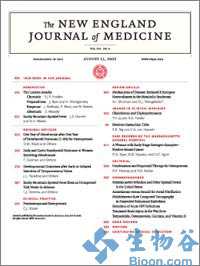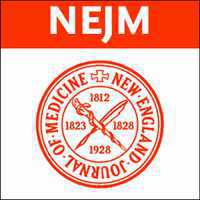NEJM: Tocilizumab可有效治疗全身性幼年型特发性关节炎
2013-05-06 shumufeng NEJM
全身性幼年型特发性关节炎(JIA)是JIA最严重的亚型,治疗选择有限,白介素(IL)-6在全身性JIA中具有致病作用。意大利罗马大学De Benedetti博士等人对此进行了深入研究,他们发现,Tocilizumab治疗严重的持续性全身性JIA有效。不良事件常见,包括感染、中性粒细胞减少和转氨酶水平升高。相关论文发表于国际权威杂志NEJM 2012年12月20日在线版。 研究人员对112例年龄为
全身性幼年型特发性关节炎(JIA)是JIA最严重的亚型,治疗选择有限,白介素(IL)-6在全身性JIA中具有致病作用。意大利罗马大学De Benedetti博士等人对此进行了深入研究,他们发现,Tocilizumab治疗严重的持续性全身性JIA有效。不良事件常见,包括感染、中性粒细胞减少和转氨酶水平升高。相关论文发表于国际权威杂志NEJM 2012年12月20日在线版。
研究人员对112例年龄为2~17岁的活动性全身性JIA(持续时间≥6个月,对非类固醇类抗炎药和糖皮质激素应答不充分)儿童进行随机分组,即在12周的双盲期内,每2周经静脉给予人抗IL-6受体抗体tocilizumab(如体重≥30 kg,按照8 mg/kg体重的剂量,如体重<30 kg,按照12 mg/kg体重的剂量)或安慰剂,对符合预先确定的无疗效反应标准的患者给予开放标签的tocilizumab治疗,所有患者均可进入一个开放标签的延长研究。
结果显示12周时,tocilizumab组达到主要终点(无发热,在美国风湿病学会为JIA设置的核心集6个变量中,至少3个的改善≥30%,恶化>30%的变量不超过1个)的患者显著多于安慰剂组[64/75例(85%)对9/37例(24%),P<0.001]。52周时,80%接受tocilizumab治疗的患者至少有70%的改善,且无发热,其中59%的患者改善达90%。此外,48%的患者无活动性关节炎,52%停用口服糖皮质激素。在双盲期内,tocilizumab组发生159次不良事件,包括60次感染(2次为严重感染),相比之下,安慰剂组发生38次不良事件,包括15次感染。在双盲期和延长期内,接受tocilizumab治疗的患者发生39次严重不良事件(0.25例/人-年),包括18次严重感染(0.11例/人-年)。19例发生中性粒细胞减少(17例为3级,2例为4级),21例转氨酶水平>正常值范围上限的2.5倍。
研究人员由此得出结论,Tocilizumab治疗严重的持续性全身性JIA有效。不良事件常见,包括感染、中性粒细胞减少和转氨酶水平升高。

DOI: 10.1056/NEJMoa1112802
PMC:
PMID:
Randomized Trial of Tocilizumab in Systemic Juvenile Idiopathic Arthritis
Fabrizio De Benedetti, M.D., Ph.D., Hermine I. Brunner, M.D., Nicolino Ruperto, M.D., M.P.H., Andrew Kenwright, B.Sc., Stephen Wright, M.D., Inmaculada Calvo, M.D., Ruben Cuttica, M.D., Angelo Ravelli, M.D., Rayfel Schneider, M.D., Patricia Woo, M.D., Ph.D., Carine Wouters, M.D., Ricardo Xavier, M.D., Lawrence Zemel, M.D., Eileen Baildam, M.D., Ruben Burgos-Vargas, M.D., Pavla Dolezalova, M.D., Stella M. Garay, M.D., Rosa Merino, M.D., Rik Joos, M.D., Alexei Grom, M.D., Ph.D., Nico Wulffraat, M.D., Zbigniew Zuber, M.D., Francesco Zulian, M.D., Daniel Lovell, M.D., M.P.H., and Alberto Martini, M.D. for the PRINTO and PRCSG
BACKGROUND Systemic juvenile idiopathic arthritis (JIA) is the most severe subtype of JIA; treatment options are limited. Interleukin-6 plays a pathogenic role in systemic JIA. METHODS We randomly assigned 112 children, 2 to 17 years of age, with active systemic JIA (duration of ≥6 months and inadequate responses to nonsteroidal antiinflammatory drugs and glucocorticoids) to the anti–interleukin-6 receptor antibody tocilizumab (at a dose of 8 mg per kilogram of body weight if the weight was ≥30 kg or 12 mg per kilogram if the weight was <30 kg) or placebo given intravenously every 2 weeks during the 12-week, double-blind phase. Patients meeting the predefined criteria for nonresponse were offered open-label tocilizumab. All patients could enter an open-label extension. RESULTS At week 12, the primary end point (an absence of fever and an improvement of 30% or more on at least three of the six variables in the American College of Rheumatology [ACR] core set for JIA, with no more than one variable worsening by more than 30%) was met in significantly more patients in the tocilizumab group than in the placebo group (64 of 75 [85%] vs. 9 of 37 [24%], P<0.001). At week 52, 80% of the patients who received tocilizumab had at least 70% improvement with no fever, including 59% who had 90% improvement; in addition, 48% of the patients had no joints with active arthritis, and 52% had discontinued oral glucocorticoids. In the double-blind phase, 159 adverse events, including 60 infections (2 serious), occurred in the tocilizumab group, as compared with 38, including 15 infections, in the placebo group. In the double-blind and extension periods combined, 39 serious adverse events (0.25 per patient-year), including 18 serious infections (0.11 per patient-year), occurred in patients who received tocilizumab. Neutropenia developed in 19 patients (17 patients with grade 3 and 2 patients with grade 4), and 21 had aminotransferase levels that were more than 2.5 times the upper limit of the normal range. CONCLUSIONS Tocilizumab was efficacious in severe, persistent systemic JIA. Adverse events were common and included infection, neutropenia, and increased aminotransferase levels.
本网站所有内容来源注明为“williamhill asia 医学”或“MedSci原创”的文字、图片和音视频资料,版权均属于williamhill asia 医学所有。非经授权,任何媒体、网站或个人不得转载,授权转载时须注明来源为“williamhill asia 医学”。其它来源的文章系转载文章,或“williamhill asia 号”自媒体发布的文章,仅系出于传递更多信息之目的,本站仅负责审核内容合规,其内容不代表本站立场,本站不负责内容的准确性和版权。如果存在侵权、或不希望被转载的媒体或个人可与williamhill asia 联系,williamhill asia 将立即进行删除处理。
在此留言









#特发性#
48
#mAb#
35
#关节炎#
38
#有效治疗#
52